Here are 7 extensions that you can only install on Google Chrome to perform a website audit.
1. Tag Assistant
This free Google extension lets you describe to your target audience check with one . Click whether Google tags (Ads, Analytics, etc.) are installed on the site you are auditing.
2. Facebook Pixel Helper
This little tool, which can be added to Google Chrome, lets you know if the site you’re visiting has installed a Facebook pixel code snippet . It’s useful for measuring the results of your campaigns and better defining your prospects .
3. Image Size Info
With this extension, you just need to “right-click” on an image to display information about the size and weight of the analyzed image, which is very important for mobile display.
4. Ubersuggest
Neil Patel’s popular content tool is also available directly in your favorite browser. Using this extension, you can, for example, discover the keywords that bring you organic traffic and perform an SEO crawl .
5. Open SEO Stats
With this extension, you can find out how many pages are indexed on different search engines. In addition, you can get an overview of interesting data about the site ( geolocation, robots.txt, sitemap.xml, etc. ) or the page ( H1, H2, etc. ).
6. SEO Search Simulator
The extension I’m presenting to you here is great for finding the positioning of your pages on Google’s SERP . Enter a keyword, the country and language of search and you will instantly know the ranking of your site.
7. Check My Links
Want to know the status of your links on a given page? This extension is the tool you need! Using color codes, you can instantly find links that are no longer valid or redirected .
SEO audit: 3 Mozilla Firefox extensions
Here are 3 handy SEO audit extensions that you’ll only find on Mozilla Firefox .
1. Foxy SEO Tool
A very interesting add-on which allows, among other things, to have an overview of all the images on a site , to find all the backlinks or even to trust review discover the SEO competitors of the page you control.
2. Flagfox
A small flag placed after the URL indicates the geolocation of the site you are currently browsing. Clicking on it will reveal further information, such as the provider’s name or IP address .
